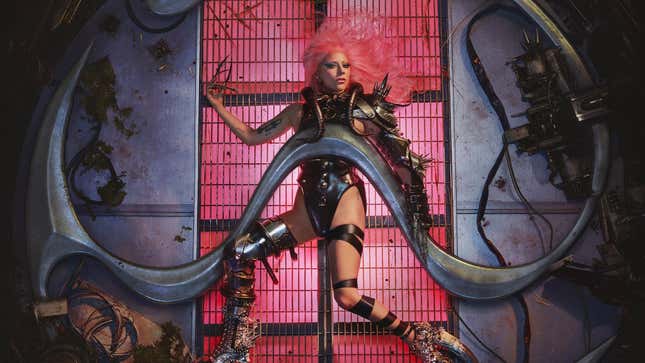

Lady Gaga’s return to dance music was supposed to be spectacular. For years, since 2013’s critically maligned ARTPOP, Gaga, at least on the surface, was shapeshifting into a more restrained, ultra-serious pop star. She recorded a jazz album with Tony Bennett, she threw on a cowboy hat and grabbed an acoustic guitar for Joanne, she made a bid for an Oscar-worthy acting career with the deeply earnest A Star Is Born. Of course, all along Gaga was still Gaga-ing, even if she was no longer rolling up to red carpets encased in an egg, like something out of Spinal Tap. Gaga was still building out her camp pastiche brick by brick, like a Jenga tower held together by overwrought Oscar performances and piano ballads. But when she released “Stupid Love,” a punchy dance song with a Star Trek-inspired video—her hair, a Pepto Bismol-pink wig—the song felt like an ecstatic return to form: here was Gaga not overthinking it, reveling in the simplicity of feel-good synth-pop, having fun.
Chromatica, Gaga’s sixth album, keeps with that simplicity. It’s a dance record through and through, though one with an intimate, emotional core as she tackles her anxiety head-on throughout. “You love the paparazzi, love the fame,” Gaga sings on “Fun Tonight” about the discrepancy between her happy party music and her real feelings. “Even though you know it causes me pain.” But there’s also lightness: the nu-disco sparkle of “Replay” and “Rain On Me” featuring Ariana Grande call to mind Kylie Minogue’s Fever. “Babylon,” the album’s cheeky closer, is molded in the image of Madonna’s “Vogue” as Gaga speak-sings about gossiping “B.C.” style. “Babble on,” she sings.
For fans, that Chromatica is a fun return to the dancefloor Gaga of yore might be enough to celebrate. But for someone at this point in her career who has constantly shifted her sound and style in so many ways, I can’t help thinking she has much better, and frankly much bigger, music in her. As much as Chromatica was positioned as Gaga’s dramatic return to dance music, the music itself is surprisingly muted. The album sometimes rolls with a festival-ready deep house sound, particularly on songs (“Free Woman,” “Sine From Above”) that call to mind producers and DJs like Kygo and Jonas Blue, whose EDM popularity peak was years ago. The robotic “911,” which has Gaga deadpan-singing about popping pills to rid the enemy that is herself, sounds like something she’d release in 2010, albeit with half the bite of a track like “Just Dance.”
If anyone has the bandwidth to get a lot weirder, it’s Gaga.
If Chromatica feels lackluster, it’s not entirely Gaga’s fault. She lives for the applause that comes with heavy promotion; touring gimmicks, incredible live television performances, outfits snapped by paparazzi. Listening to “Sour Candy,” featuring BLACKPINK, who body every music video they make, I wondered if the song’s uninspired Maya Jane Coles-biting (aka “Truffle Butter”) beat would have been forgiven with the help of a moment-making music video. But amidst covid-19, which initially made Gaga push back Chromatica’s release, she doesn’t necessarily have all the accessories that can turn a Gaga release into the spectacle she’s known for.
But it’s not just the moment and Gaga’s hindered promotion that keeps Chromatica feeling restrained. Gaga, like so many pop stars before her, has moved through her career in distinct musical phases, and Chromatica is no exception. It has such a unified sound and style, but perhaps to its detriment. When I think about pop music that pushes the genre forward, it comes from artists who are willing to take risks in the studio. Think of Beyoncé, who listens to songwriters and producers like Rae Sremmurd, Ezra Koenig, and Caroline Polachek when assembling her albums, or Rihanna who was derided for Anti lacking a point of view but was filled to the brim with songs that were islands onto themselves; who cares if “Love On the Brain” didn’t make sense on the same album as “Kiss It Better?” Ariana Grande’s best song in years, “thank u, next” was honed by writers Tayla Parx and Victoria Monét, two relative newcomers her own age.
Gaga doesn’t assemble albums a la carte, and I wouldn’t expect her to; she creates distinct mini-worlds and lives in them for a whole cycle. But that’s the old school way, one still clinging to a time when people listened to an entire album front to back, which Gaga hopes you’ll do even if the record is divided into three sections. I wonder why she isn’t taking bigger risks, expanding her collaborative circle, and looking beyond producers like BloodPop, who produced almost all of Chromatica, for an album that purports to celebrate dance music. If anyone has the bandwidth to get a lot weirder, it’s Gaga.
But maybe Chromatica wasn’t the release for her to let her freak flag fly even higher. Chromatica doesn’t break ground for pop or Gaga. Instead it plays like a cleaning up of Gaga’s musical slate, bringing her back into the folds of club music and the bubblegum fun that launched her career, a creative release that sounds like one long exhale.